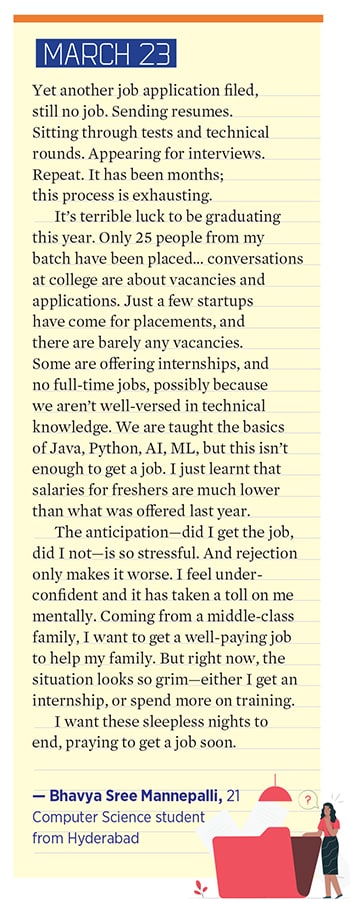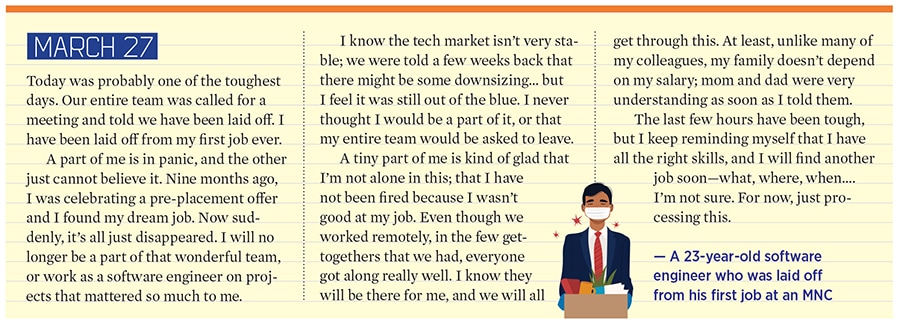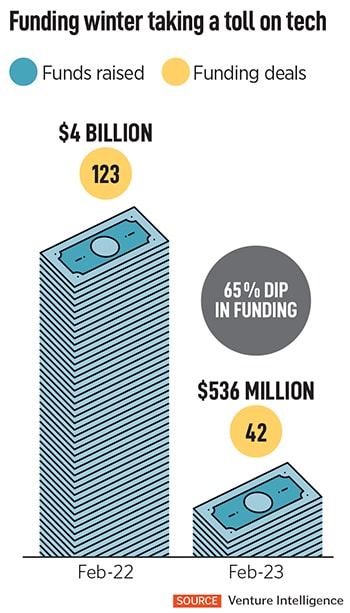Flood of layoffs, dropping job volumes and changing work trends: Troubles in liv
Once the middle class's dream, the IT sector is now beset with layoffs and job problems. Will it see light at the end of the tunnel?


In the introduction to Kris Gopalakrishnan’s Against All Odds: The IT Story of India, author Gurcharan Das wrote: “The quiet economic and social revolution unleashed by IT is the cheeriest story of India’s recent economic ascent..." In the same book, Infosys Founder NR Narayana Murthy is quoted saying that along with investing adequately in research and development, improving work productivity, and enhancing innovation capabilities, “our job is to attract the best and the brightest". Industry body Nasscom says the Indian IT industry directly employed 5.1 million people in FY22, and generated $226 billion in revenue.
IT services has been the Indian middle class’s dream since the early ’90s. However, the recent turn of events represents another story. These diary entries (see below) of tech workers represent the predicament the sector is going through.
Hiring in the IT sector has dropped by 25 percent versus last year, as per the Naukri JobSpeak Report (January 2023). India’s top four IT companies saw a net addition of just 1,940 employees in Q3, the lowest in the last eight quarters. Most of these companies have been delaying onboarding of new employees, some have reportedly offered close to 50 percent salary cuts in exchange for immediate placement. Active job volumes in the tech sector have dropped by nearly 50 percent on a year-on-year basis, according to staffing firm Xpheno.
There has been a flood of news reports about layoffs: Accenture plans to cut 19,000 jobs Indeed to lay off 2,200 (15 percent) employees Amazon said it will layoff 9,000 people, in its second round of job cuts GitHub has laid off its entire engineering team in India (over 100 jobs) Disney announced three rounds of layoffs, that could affect about 7,000 employees. Indian startups have already laid off close to 5,000 people in 2023, as per Layoffs.fyi, and the next few months will see many more.
 Experts believe this should be taken as a cyclical movement. However, for tech workers and students looking for jobs in the sector, it is a nightmare.
Experts believe this should be taken as a cyclical movement. However, for tech workers and students looking for jobs in the sector, it is a nightmare.
“Macroeconomic conditions are very poor. With the current BFSI turmoil, a lot of IT services companies are getting hit. It is expected that the tech sector will be in turmoil for at least another six months," says Siva Prasad Nanduri, chief business officer, at TeamLease Digital. The last two years saw ambitious hiring, especially due to the pandemic. “Everyone wanted to go digital at the time, and there was a huge demand for tech professionals, which led to a lot of hiring. I believe this is a form of load-shedding," explains Niraj Hutheesing, founder and director of software company Cygnet Infotech.
Layoffs are only happening at large companies that hired a lot of people, and not as much at mid-sized companies or startups. Though some startups haven’t been firing people, investors have informed founders to be conservative with hiring and hikes. Amid this funding winter, if companies are unable to raise funds in the next six to eight months, it might be tough for them to survive.
Lately, most of the top tier IT services companies are insisting that employees return to offices. Narayana Murthy, for instance, warned youngsters against moonlighting and working from home while speaking at the Asia Economic Dialogue in March. He said, “My fervent desire and humble desire to youngsters is please don’t fall into this trap of ‘I will moonlight’, ‘I will do work from home’, ‘I will come to office three days in a week’."
Some mid-sized companies though, such as Cygnet, are offering hybrid work options. “We prefer having employees coming to work, specifically for collaborative engagements. But offering hybrid work as an option is very attractive for employees and it helps us secure good tech talent," says Hutheesing. Cygnet, like many other tech companies has seen good talent joining from tier 2 and 3 cities, where the company has set up satellite offices for them to work from twice a week.
However, startups continue to offer remote work as an option. For startups like SALT, a fintech platform that was founded during the pandemic, remote work was the only way to go. Anshul Mittal, co-lead, engineering at SALT, says: “To mimic an ‘office-like’ atmosphere, we have a virtual office setup via a Zoom link that runs all day long with multiple breakout rooms. This model works for us, since we are a team of only 30 people. However, larger tech firms are insisting that people come to work, because they have large teams, and it’s easy for people to slack off." SALT’s team ends up meeting at various locations once in four to six months.
Be it a tech worker at a small startup or a large tech giant, the fear of being laid off is on everyone’s mind. As compared to the highest active demand of 273,000 from the tech sector collective, the current demand levels are nearly a 55 percent drop, according to Xpheno. Kamal Karanth, co-founder, Xpheno, explains: “It is important to note the relative drop in the tech sector’s contribution to overall active job demands in India. From the highs of over 80 percent contribution, it has dropped to under 45 percent over the year."

Even increments for the sector are expected to drop from 10.3 percent in 2022 to 9.1 percent in 2023, according to Deloitte’s India Talent Outlook 2023 study. Karanth adds, “The global layoff count since 2022, exceeding over 2,000 rounds, is nearly half a million employees. With nearly two-third of the impacted staff in the US, the rest of the world contributes to one-third. India ranks second in the layoffs count, with an impact in the 35,000 to 40,000 range."
 For freshers who will graduate this year, like computer science student Bhavya Sree Mannepalli, job prospects are not looking great. Most companies are opting for students who have a few years of work experience. Why? “A lot of freshers have technical knowledge, but lack domain and functional skills. When we started our careers, we got these skills on the job floor. Freshers need these skills to improve their employability. Since people with good domain and functional skills are scarce in the market, they are paid a lot more too," explains Hutheesing. The pay gap between freshers and experienced employees, hence, over the years, has only widened. Mannepalli adds, “My seniors were getting salary packages of ₹4.2 lakh last year this year it is ₹3-3.5 lakh."
For freshers who will graduate this year, like computer science student Bhavya Sree Mannepalli, job prospects are not looking great. Most companies are opting for students who have a few years of work experience. Why? “A lot of freshers have technical knowledge, but lack domain and functional skills. When we started our careers, we got these skills on the job floor. Freshers need these skills to improve their employability. Since people with good domain and functional skills are scarce in the market, they are paid a lot more too," explains Hutheesing. The pay gap between freshers and experienced employees, hence, over the years, has only widened. Mannepalli adds, “My seniors were getting salary packages of ₹4.2 lakh last year this year it is ₹3-3.5 lakh."
The larger tech giants, in such cases, offer training programmes or internships for a few months before they hire students full-time. For instance, according to reports, Wipro requires new hires to undertake a four-to-six-month training programme called ‘Velocity’. If students like Mannepalli don’t get jobs or internships, they would need to look at upskilling further at training institutes in cities like Ameerpet, known for its software training institutes. “Each course there costs about ₹30,000. Once you pass out of one of those institutes, they help you get an internship and eventually a job," she says.

According to reports, net hiring of engineers is likely to crash by close to half year-on-year in the next fiscal. Staffing firm TeamLease expects a 40 percent drop in FY24 headcount addition vis-a-vis FY23 addition, based on the current outlook from companies. Skilled AI professionals are in demand, and there were 45,000 job openings in India for AI roles last month. “Certain sectors such as gaming, cybersecurity, Web3 and blockchain are booming and seeing a lot more job vacancies and demand," says Nanduri of TeamLease Digital. A Naukri JobSpeak report suggests there is an increasing demand for specialist roles in tech such as, analytics managers, big data engineers, cloud system administrators, and augmented reality QA Testers.
According to Nasscom, the tech sector is set to close FY23 with a nearly 9 percent growth over FY22—from $226 billion to $245 billion. Adds Karanth, “This compared to the hyper-buoyant FY22 saw 15 percent as a record growth year in over a decade. The current year’s growth is still a positive statement of the sector’s foundations and resilience. With the IT Service bellwethers showcasing a healthy order book pipeline of nearly $20 billion, the tough times may not last too long."
First Published: Apr 11, 2023, 15:14
Subscribe Now